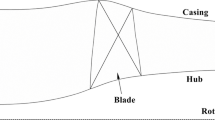Abstract
A study of leeward vortex structure over chined fuselage and the effects of micro tip perturbation on its vortex flow have been carried out in wind tunnel experiments at Reynolds numbers from 1.26×105 to 5.04×105 with PIV and pressure measurement techniques. Firstly, the experiment results have proved that micro tip perturbation has no effects on the vortex flow and its aerodynamic characteristics over chined fuselage at high angle of attack, in which there are not any non-deterministic flow behaviors. Secondly, the evolution of leeward vortex structure over chined fuselage along the axis of model can be divided into four flow regimes: linear conical developed regime, decay regime of leeward vortex intensity, asymmetric leeward vortex break down regime and completely break down regime. And a correlation between leeward vortex structure and sectional aerodynamic force was also revealed in the present paper. Thirdly, the experiment results show the behavior of leeward vortex core trajectories and zonal characteristics of leeward vortex structure with angles of attack. Finally, the experiment results of Reynolds number effect on the leeward vortex flow have further confirmed research conclusions from previous studies: the flows over chined fuselage at high angles of attack are insensitive to variation of Reynolds number, and there is a little effect on the secondary boundary layer separation and the suction peak induced by leeward vortex.
Similar content being viewed by others
References
Jeans T L, McDaniel D R, Cummings R M, et al. Aerodynamic analysis of a generic fighter with a chine fuselage/delta wing configuration using delayed detached-eddy simulation. AIAA Paper 2008-6228, 2008
Cai J S, Cui Y D, Tsaia H M. A combined experimental and analytical investigation of the vortex stability over sharp-edged slender bodies. Physics of Fluid, 2007, 19: 087103
Arena Jr A S, Nelson R C, Schiff B. Directional control at high angles of attack using blowing through a chined forebody. J Aircraft, 1995, 32(3): 596–602
Cummings R M, Schiff L B, Duino J D. Experimental investigation of tangential slot blowing on a generic chined forebody. J Aircraft, 1995, 32(4): 818–824
Roos F W, Kegelman J T. Aerodynamic characteristics of three generic forebodies at high angles of attack. AIAA Paper 91-0275, 1991
Kegelman J T, Roos F W. Influence of forebody cross-section shape on vortex flowfield structure at high alpha. AIAA Paper 91-3250, 1991
Hall R M. Influence of forebody cross-sectional shape on wing vortex burst location. AIAA Paper 86-1835, 1986
Deng X Y, Wang Y K. Asymmetric vortices flow over slender body and its active control at high angle of attack. ACTA Mechanica Sinica, 2004, 20(6): 567–579
Chen X R, Deng X Y, Wang Y K. Influence of nose perturbations on behaviors of asymmetric vortices over slender body. ACTA Mechanica Sinica, 2002, 18(6): 581–593
Deng X Y, Tian W, Ma B F, et al. Recent progress on the study of asymmetric vortex flow over slender bodies. ACTA Mechanica Sinica, 2008, 24(5): 475–487
Chen X R. Perturbation effect and active control on behaviors of asymmetric vortices over slender body (in Chinese). Dissertation of the Doctor Degree. Beijing: Beijing University of Aeronautics and Astronautics, 2003. 29–55
Mange R L, Roos F W. The aerodynamics of a chined forebody. AIAA Paper 98-2903, 1998
Lamont P J. Pressures around an inclined ogive cylinder with laminar, transitional, or turbulent separation. AIAA J, 1982, 20(10): 1492–1499
Deng X Y, Bo N, Ma B F, et al. Effect of Reynolds number and zonal characteristics on asymmetric vortices over slender body (in Chinese). Acta Aerodynamic Sinica, 2007, 25(Suppl): 48–52
Bo N, Deng X Y, Wang Y K. Simulation experimental technique and primary study of Reynolds number effect on vortex asymmetry at forebody (in Chinese). J Beijing University of Aeronautics and Astronautics, 2006, 32(12): 1408–1412
Bo N. The study on Reynolds number effect of asymmetric vortices flow structure over forebody (in Chinese). Dissertation of the Doctor Degree. Beijing: Beijing University of Aeronautics and Astronautics, 2008. 52–71
Jouannet C, Munro C, Muller S, et al. Water tunnel investigation of chined forebody characteristics at high angles of attack. AIAA Paper 2003-3414, 2003
Wardlaw A B, Morrison A M. Induced side forces on bodies of revolution at high angle of attack. J Spacecraft, 1975, 13(10): 589–593
Author information
Authors and Affiliations
Corresponding author
Rights and permissions
About this article
Cite this article
Tian, W., Deng, X., Wang, Y. et al. Study on flow behavior and structure over chined fuselage at high angle of attack. Sci. China Technol. Sci. 53, 2057–2067 (2010). https://doi.org/10.1007/s11431-010-3141-2
Received:
Accepted:
Published:
Issue Date:
DOI: https://doi.org/10.1007/s11431-010-3141-2



